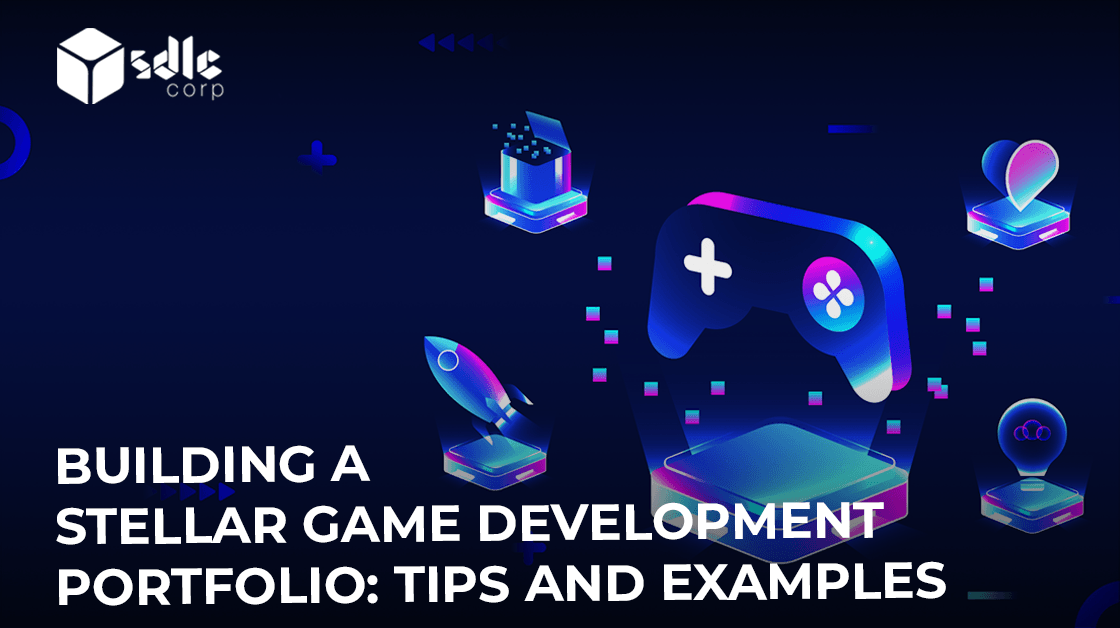Building a Stellar Game Development Portfolio: Tips and Examples
Game development is a highly competitive field, and building an impressive portfolio is essential for standing out and landing your dream job. With many aspiring game developers vying for attention, showcasing your skills effectively can be challenging.
In today’s industry, especially in the growing sectors like Web3 game development services and Metaverse NFT game development, it’s crucial to show rather than tell potential employers what you’re capable of. While your experience, degree, and résumé are essential, a well-crafted portfolio allows you to demonstrate your technical skills, problem-solving abilities, and creativity in ways that a résumé alone cannot.
This blog will provide tips and examples to help you build a stellar game development portfolio that highlights your abilities and captures the attention of potential employers, including those from game development companies and blockchain game development companies looking for innovative talent.
Stellar Game Developers
Stellar game developers possess a unique combination of creativity, technical expertise, and a passion for pushing the boundaries of gaming. Whether working on traditional games or cutting-edge projects like custom blockchain development and smart contract development, these developers have the ability to turn innovative ideas into engaging gameplay experiences. They continually push the envelope with technology, creating immersive worlds and mechanics that captivate players for hours. The potential for personal growth and learning in this field is immense, inspiring you to reach new heights in your career.
Attention to detail, technical proficiency in areas like blockchain development, and a commitment to excellence set stellar game developers apart. These professionals actively seek feedback from players and their community, refining their games to meet and exceed expectations. Your dedication not only shapes individual projects but also contributes to the evolution of the gaming industry, especially as it expands into new frontiers like blockchain-based games and the metaverse. You are a key player in this exciting journey.
By crafting a standout portfolio, aspiring developers can demonstrate their passion and skill set to potential employers, particularly in specialized areas such as Web3 and blockchain game development.
Partner with a leading game development company today!

Tips and Examples for Building an Impressive Game Development Portfolio
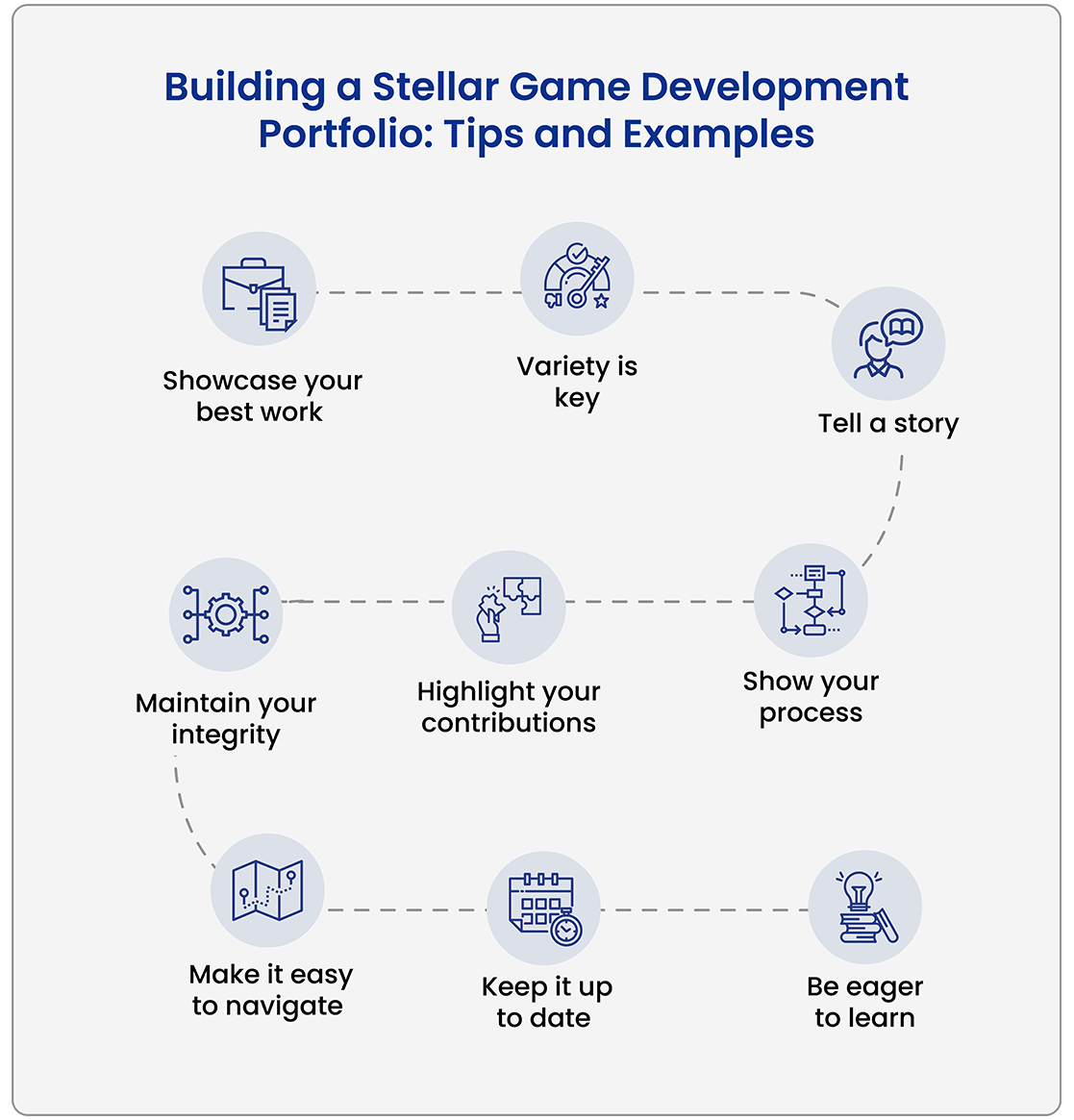
1. Showcase Your Best Work
When building a game development portfolio, showcasing your best work is essential. Your portfolio should be a collection of your most impressive and polished projects. It’s better to have a few high-quality pieces than many mediocre ones.
Be selective and only include projects demonstrating your skills, creativity, and passion for game development.
You should constantly strive for quality, and whatever you can demonstrate with that quality range should be included in your portfolio. Essentially, Your best work.
2. Variety is Key
While showcasing your best work is essential, showing variety in your portfolio is also important. Employers want to know that you can handle various projects and have many talents.
Include games that showcase different genres, gameplay mechanics, art styles, and platforms. This will demonstrate your ability to adapt to other projects and challenges.
3. Tell A Story
A good game development portfolio should tell a story. It should take the reader on a journey and showcase your growth and development as a game developer. Start with your earliest projects and progress to your most recent work.
Finally, show how you’ve evolved and improved over time. We all grew up on stories, and humanity grew up on myths and legends. Thus, the story is significant. The entertainment industry is built on storytelling, fantastic effects, and lots of explosions, but at the heart of it, all is a compelling story.
As a result, each piece should tell us a story. This will give potential employers insight into your development process and how you approach game development.
4. Show Your Process
In addition to showcasing your best work, showing your process is essential. This can include sketches, concept art, prototypes, and design documents. This will give potential employers a glimpse into your creative process and how you approach game development. It’s also an opportunity to demonstrate your problem-solving abilities and close to design difficulties.
5. Highlight Your Contributions
When working on a team project, it’s essential to highlight your contributions. This can include your specific role, responsibilities, and achievements. Also, credit your team members, as game development is often collaborative. This will demonstrate your ability to work on a team and your understanding of the game development process.
6. Maintain Your Integrity
I’ve seen hundreds and dozens of portfolios with a little bit of 2D, a little bit of 3D, styled things, environment stuff, a mixture of everything, and I really can’t tell what that individual is all about, what the person appreciates. Being yourself is one of the most important things you can do.
You want people to become acquainted with you through your work. If you’re all over the place and appear to want to please everyone, you lose that quality, that edge, and distinctiveness.
Unlock innovation with a Web3 game development company!

7. Make it Easy to Navigate
A good game development portfolio should be easy to navigate. Use clear headings and organize your projects by genre or platform. Use screenshots, videos, and gameplay footage to showcase your work.
Please include a summary of each project, including the platform on which it was built, the tools and technologies employed, and your specific involvement.
Explore our other insights!
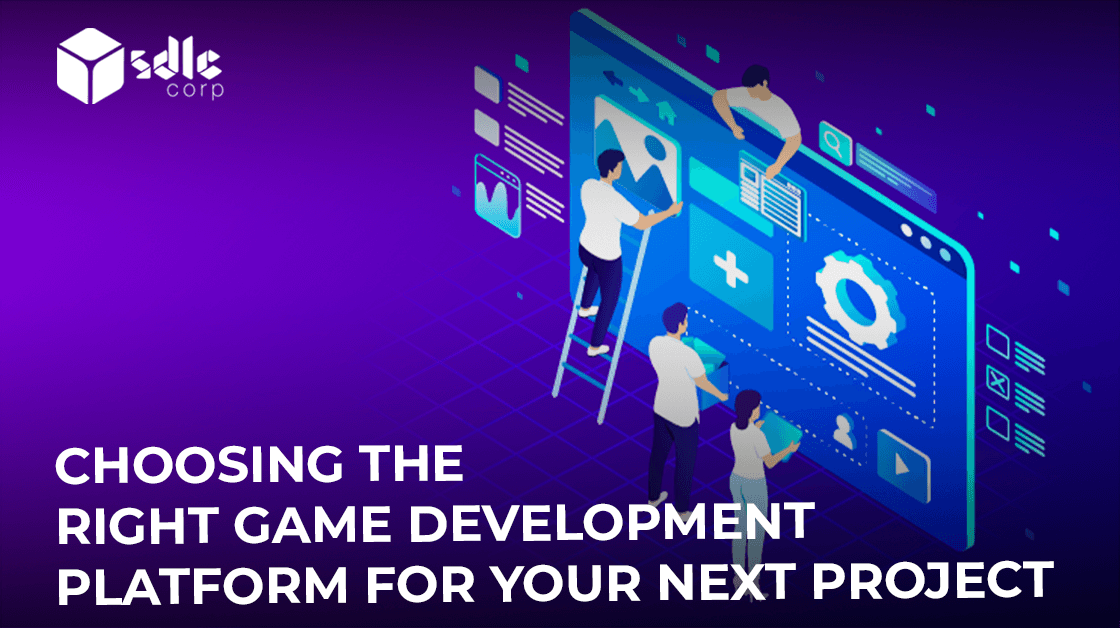
Choosing the Right Game Development Platform For Your Next Project
Choosing the right Game Development Platform for your next project In recent years, making games has become popular
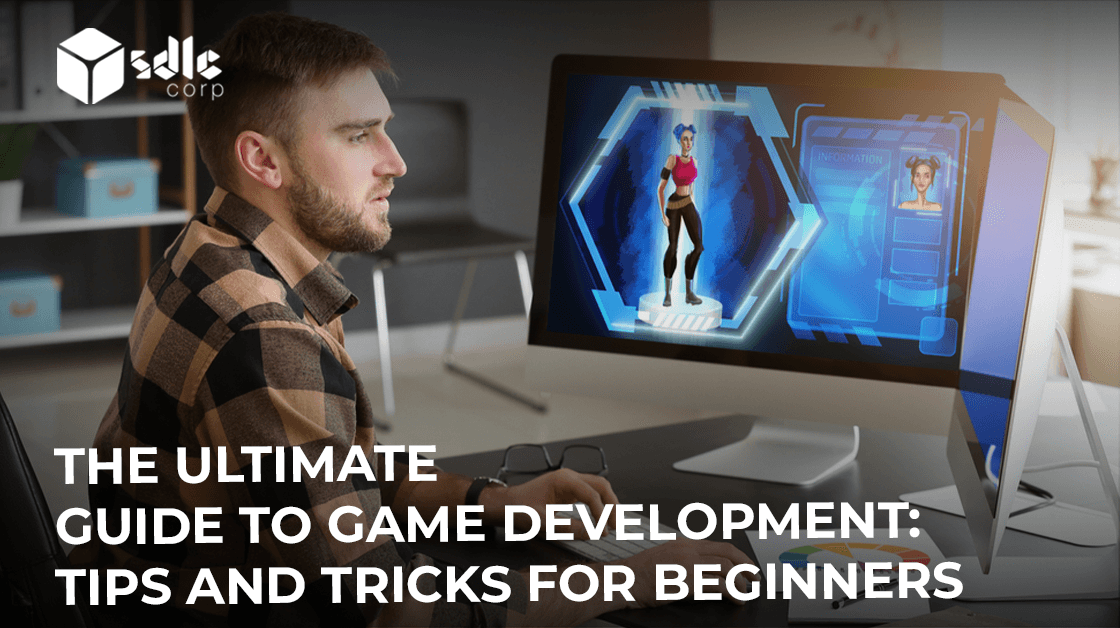
The Ultimate Guide to Game Development: Tips and Tricks for Beginners
Game development is an exciting and interesting subject that has grown in prominence in recent years. With the
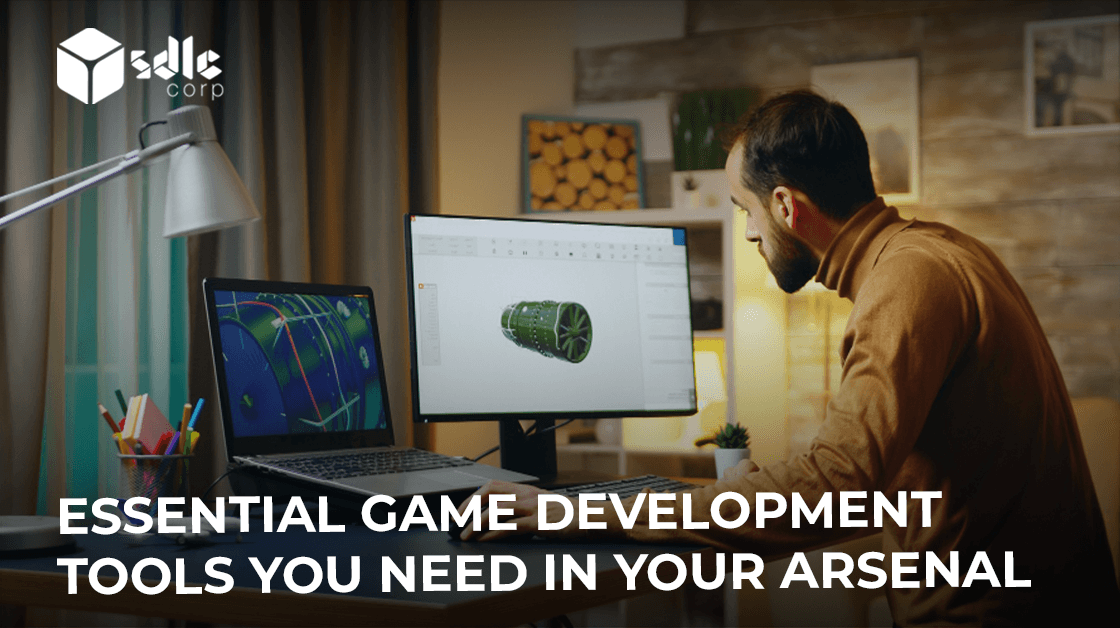
Essential Game Development Tools You Need in Your Arsenal
Essential Game Development tools you need in your Arsenal Creating video games is intricate and demanding, requiring a
8. Keep it Up to Date
Finally, it’s essential to keep your portfolio up to date. Game development is constantly evolving, and employers want to see that you stay current with the latest technologies and trends.
So update your portfolio regularly and showcase your most recent work. This will demonstrate your commitment to game development and your passion for the industry.
9. Be Eager to Learn
I review thousands upon dozens of portfolios. Within ten people, there will be five to seven portfolios where that person could get anywhere if they put in more effort. After providing comments, I advise folks to contact me again within three to six months. Unfortunately, only some people take advantage of this opportunity.
Returning can leave an excellent impression on the individuals you’re interviewing, which can enhance their prospects in the long term. Applying for a job repeatedly if you don’t get it the first time can be helpful. Ensure you’re adding to your portfolio and that it’s at least a little better than last. If you want the job, you need to put in the effort.
Examples of Stellar Game Development Portfolios
To give you some inspiration, here are a few examples of stellar game development portfolios:
Lauren Scott
Lauren Scott’s portfolio showcases her impressive game design, programming, and art skills. She includes a variety of projects that demonstrate her versatility and creativity, including platformers, puzzle games, and interactive art installations. Her portfolio is well-organized and easy to navigate, with clear headings and concise descriptions of each project.
Richard Lems
Richard Lems’ portfolio is an excellent example of storytelling. He takes the reader through his development process, starting with his earliest projects and progressing to his most recent work. He includes concept art, prototypes, and design documents, giving potential employers a glimpse into his creative process. His portfolio also showcases
David Shaver's
David Shaver is a game developer with experience in programming, design, and project management. His portfolio includes several games demonstrating his skills in these areas, such as the puzzle game “Cubikolor” and the platformer “Chronology.”
Amanda End's
Amanda End is a 3D artist and game developer specializing in character and creature design. Her portfolio features a range of stunning 3D models, including characters from “Overwatch” and “League of Legends.”
Liam de Koster's
Liam de Koster is a game designer and programmer with experience in Unity and C#. His portfolio includes several games, including “Neon Hook,” a stylish first-person platformer, and “Bewitched,” a puzzle game that uses teleportation mechanics.
Hire dedicated game developers to boost success!

Conclusion
Securing a position as a game developer becomes much easier when you have a well-crafted portfolio that showcases your skills and creativity. A portfolio not only demonstrates your ability to work in the gaming industry but also makes you a more attractive candidate to potential employers by providing tangible proof of your capabilities.
While there’s no one-size-fits-all approach to creating a standout portfolio, following the tips outlined in this blog will give you a solid foundation. Remember, portfolios are never truly finished—there’s always room to improve the presentation, add new projects, or refine existing ones. Whether you’re working on traditional game development or exploring exciting new areas like Web3 game development services or Metaverse NFT game development, your portfolio will evolve as you do.
If you need additional guidance or professional support, we’ve provided some valuable resources below. We wish you the best of luck in your search for a game development role, and we encourage you to continue honing your craft!
Game Development Services by SDLC CORP
SDLC CORP offers a wide array of game development services, helping you bring your creative ideas to life across various platforms and genres. Whether you’re a game developer looking to enhance your skills or a company needing custom solutions, SDLC CORP can support your journey in areas such as:
- Game Development Company
- Android Game Development Company
- NFT Game Development Company
- 2D Game Development Company
- 3D Game Development
- Mobile Game Development Company
- Unity Game Development Company
- Ludo Game Development Company
- PC Game Development Company
- Unreal Engine Game Development Company
- Casino Game Development Company
- Kids Game Development Services
- Fantasy Game Development Company
- Play-to-Earn (P2E) Game Development Company
- VR Game Development Company
- Rummy Game Development Company
- Augmented Reality Game Development Company
- Board Game Development Company
- Console Game Development
- Texas Hold’em Game Development Company
- Sports Game Development Company
- Video Game Consulting Company
- Card Game Development Company
- Battle Royale Game Development Company
- Slot Game Development Company
- Poker Game Development Company
SDLC CORP also specializes in emerging technologies, offering solutions like blockchain development, custom blockchain development, and smart contract development to support innovative gaming projects. Partner with SDLC CORP, a leading blockchain game development company, and elevate your gaming experiences with cutting-edge technology.
FAQs
1. What is a game development portfolio?
A game development portfolio is a collection of your best work as a game developer. It usually includes showcasing your skills, experience, and accomplishments in game development. In addition, a portfolio can consist of various elements such as game demos, concept art, coding samples, design documents, and project descriptions.
2. Why is having a game development portfolio significant?
A game development portfolio is significant because it showcases your skills and experience as a game developer to potential employers or clients. It also allows you to demonstrate your creativity, problem-solving abilities, and technical expertise to the industry. A great portfolio will help you stand out and boost your chances of being employed or chosen for assignments.
3. What should be included in a game development portfolio?
A game development portfolio should include various elements that showcase your skills and experience in game development. This may include game demos, screenshots or videos, coding samples, design documents, project descriptions, and any awards or recognition you have received. It’s also important to highlight your role in each project and provide context around the challenges you faced and how you overcame them.
4. How many projects should I put in my collection of games I've done?
The number of projects in your game development portfolio should vary depending on your experience level and the quality of your work. It’s better to focus on a few high-quality projects rather than include many mediocre ones. A good rule of thumb is to showcase your best work from the past 2-3 years.
5. Should I include personal projects in my game development portfolio?
Yes, including personal projects in your game development portfolio can be a great way to showcase your creativity and passion for game development. Individual projects demonstrate your ability to work independently and bring your ideas to life. First, however, make sure that your projects are relevant and high-quality.
Contact Us
Let's Talk About Your Project
- Free Consultation
- 24/7 Experts Support
- On-Time Delivery
- sales@sdlccorp.com
- +1(510-630-6507)

